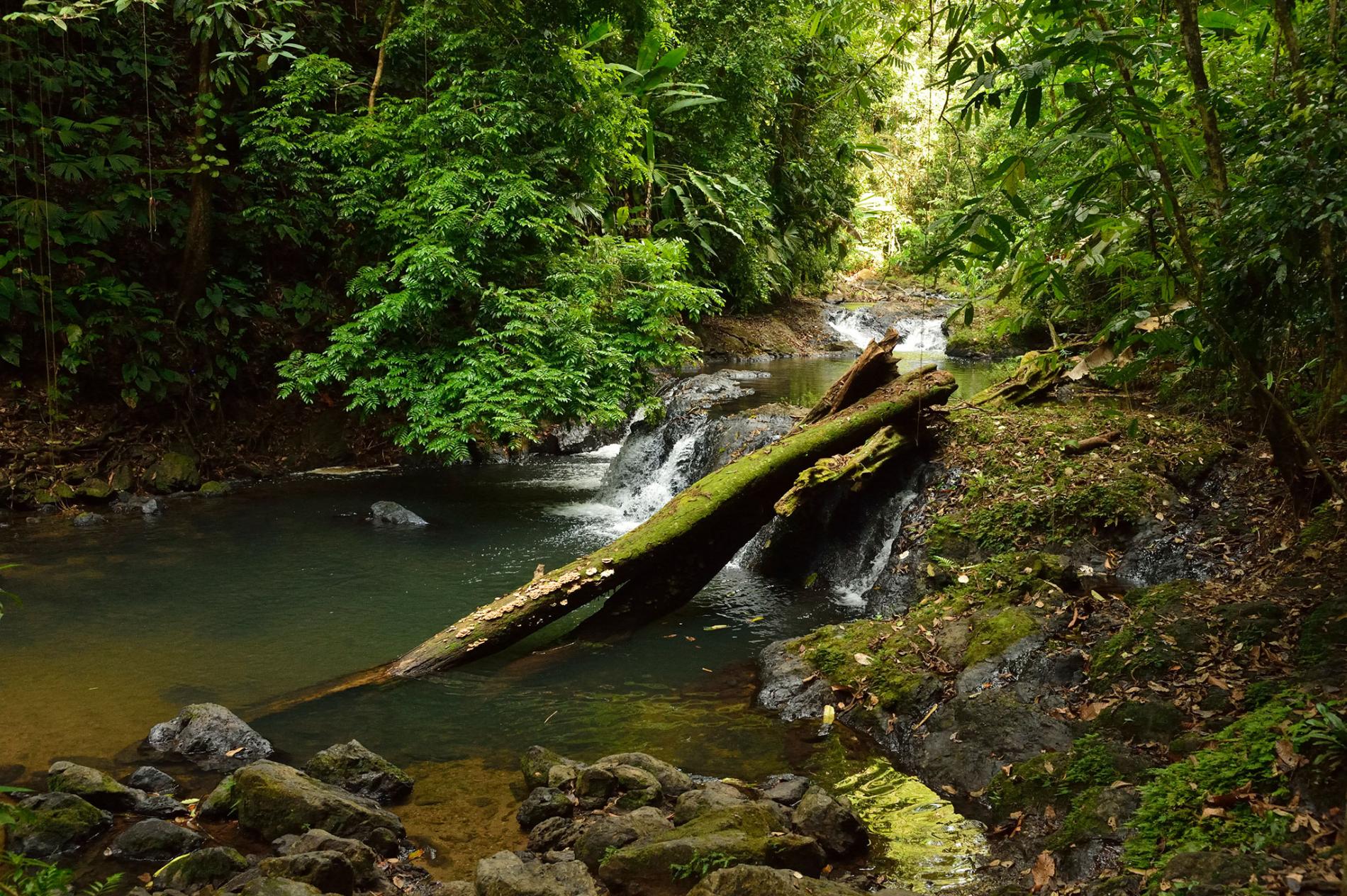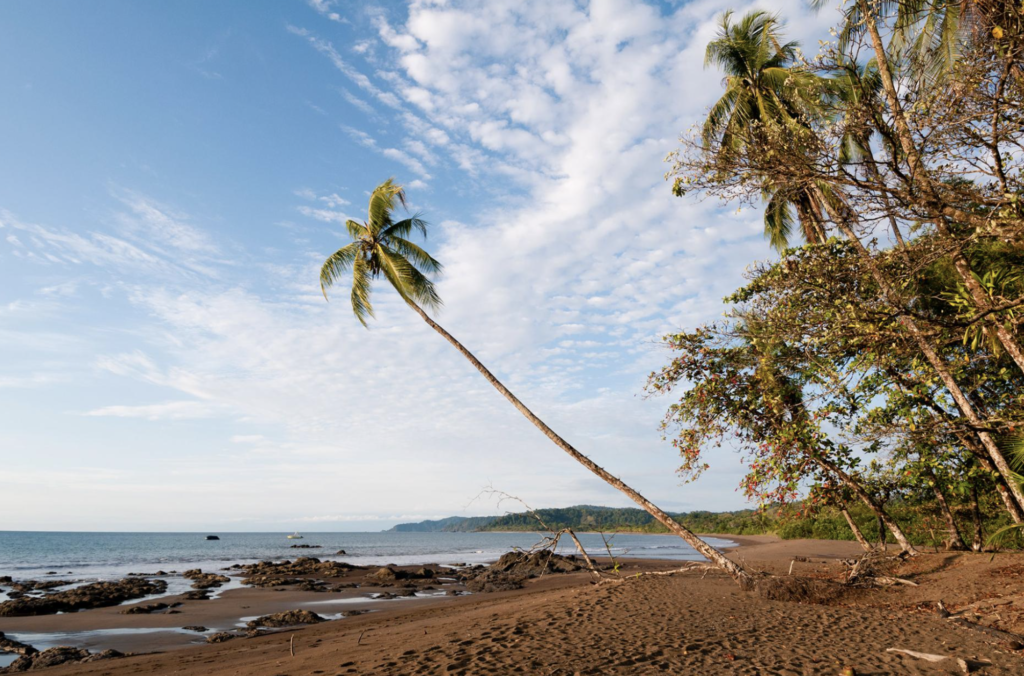Tourism Could Make or Break This Biodiverse Haven
Friday 21 September, 2018 - Author: Sunny Fitzgerald

Small waterfalls flow through a swimming hole in Corcovado National Park, the largest national park in Costa Rica. PHOTOGRAPH BY JONATHAN KINGSTON, NAT GEO IMAGE COLLECTION
A trio of pantropical spotted dolphins slices through the surface of Golfo Dulce—Costa Rica’s southernmost bay, tucked between the mainland and the Osa Peninsula. Their sleek black figures barely cause a ripple before gliding back beneath the glassy water. There’s not another boat or human in sight, save the six of us aboard a small research vessel. “Spotted dolphins—traveling or foraging?” I scrawl in my notes, the scratch of my pencil the only sound to break the silence.
Golfo Dulce, meaning “Sweet Gulf,” is one of only a handful of tropical fjord-like estuaries in the world. The unique marine habitat is home to over 20 percent of Costa Rica’s Pacific coast marine life, including hawksbill turtles and bottlenose and spotted dolphins. Its warm waters are also ideal breeding and nursing grounds for migrating humpback whales.
Five years have passed since that day I spent in Golfo Dulce documenting the behavior of dolphins with the Centro de Investigación de Cetáceos (Center for Cetacean Research, or CEIC). But the memory of it is still as crisp and colorful as the brilliant blues and greens of the bay. It was my first encounter with the fragile ecosystems and enchanting beauty found in and around the Osa, a region that boasts 2.5 percent of the world’s biodiversity on just three millionths of the Earth’s surface. In that moment—as I sat mesmerized by the fluid movements of the marine mammals in their serene sanctuary—I could see both the opportunity and the liability that such a wealth of natural wonders presents.

A red-eyed tree frog stares from a leaf in Corcovado National Park.
PHOTOGRAPH BY DANIELA LINARES, ANZENBERGER/REDUX
Natural beauty: A blessing and a burden?
“Beauty is a double-edged sword,” says Dr. Lenin E. Oviedo Correa, a chief scientific advisor and research associate with CEIC.
Travelers to the Osa are understandably attracted to this pristine paradise and intrigued by its wild side where multiple nature reserves, including Corcovado National Park, offer the chance to trek untamed rainforests and spot endemic or endangered species such as scarlet macaws, Golfo Dulce poison dart frogs, and Baird’s tapirs in their native habitat. And in a region so rich in natural resources yet economically impoverished—an estimated 35 percent of the residents live in poverty—many locals are eager to welcome visitors.
“Ecotourism is an opportunity,” Correa says, but “if you’re thinking of what you can get rather than what you can preserve, it can be pervasive.”
Over the years and in the face of proposed development projects that have included an international airport, a marina with 250-plus slips, and a large, internationally-branded resort, the Osa has repeatedly confronted difficult questions: Will the Osa be empowered by tourism or overrun by it? Will its beauty be its greatest asset or cause its ultimate demise? Is sustainable development possible in paradise?
Homegrown possibilities
Expansion has not been as swift as expected: The international airport project never fully got off the ground, and the construction of Botánika Resort and the expanded marina at Crocodile Bay Resort have been delayed. Botánika developers state that the delay is due to improvements to the master resort plan, not permit issues or pushback. The potential presence of large-scale development projects like these, however, seems to have sparked some local entrepreneurs, environmentalists, and even foreign filmmakers to step up their own homegrown efforts.
According to Eytan Elterman, filmmaker and cofounder of Lokal, a community-based tourism booking platform, rural tourism activities operated by locals in the Osa have significantly improved and increased in recent years. Elterman sees the growth of community-based tourism “as a direct result of the threats of the airport,” he says. The airport could have meant large-scale development, he says, and “community tourism was a counter to that.”
2.5% – The Osa Peninsula Trailer from Lokal Media on Vimeo.
2.5% – The Osa Peninsula, a documentary created by Elterman and Bollinger, offers a glimpse into the lives of a few Osa residents.
2.5% – The Osa Peninsula, a documentary created by Elterman and Lokal cofounder Marco Bollinger, offers a glimpse into the lives of a few Osa residents who desperately desire economic opportunities and have been working to create a livelihood through low-impact, community-based tourism projects.
Ifigenia Garita Canet, tropical biologist and founder of Costa Rican ecotourism operator Osa Wild, agrees that responsible, community-based ecotourism presents one possibility for protecting the environment and culture of the Osa while creating income for locals. But she’s not stopping there. Canet believes environmental education and embracing traditional knowledge is key. “We need to empower the [local] people and allow them to believe that we can benefit from nature, from traditional knowledge, from the information provided by their ancestors,” she writes. Schools should emphasize sustainability, conservation, and biodiversity, she says, and people should be encouraged to view tourism as not the only alternative and instead “use nature as a way of living,” growing crops and creating unique products and handcrafts from natural materials.

A quiet, brown sand beach beckons along Drake Bay.
PHOTOGRAPH BY SERGIO PITAMITZ, NAT GEO IMAGE COLLECTION
Correa echoes the sentiment, expressing that a holistic approach to sustainable development requires more comprehensive instruction. “One major gap is education,” he says. “We do not have environmental education that is effective.” Like Canet, he believes that the community may already possess answers of its own. “The first thing that comes to mind when we talk about empowering the community is to teach them how to do things. But we aren’t considering they might know how to do things better than we do.”
Sustainability: A shared responsibility
Correa insists that visitors, too, are a significant part of the equation. “We need more awareness among the locals, but we also need more educated visitors,” he says. “There is no interpretation center in Golfo Dulce or Puerto Jiménez to receive the tourists and provide info to them.”
If visitors are better informed on best practices for viewing wildlife, there is a reduced risk of intrusive activities—such as pressuring or even paying boat captains to chase dolphins and whales—that can disrupt wildlife behavior or destroy the habitat.
Elterman also urges travelers to educate themselves. “Understand where your money is going. Up to 95 percent of foreign travel dollars don’t stay in local communities,” he says. “It’s important to help empower local entrepreneurs and understand when you support locals, you are giving them the power to maintain ownership of their land and giving them economic options.”
Alternative ways to earn money are particularly important in poverty-stricken and environmentally fragile places like the Osa, where residents may otherwise resort to illegal and destructive activities when presented with limited options.
“If small businesses such as family-run eco-lodges are forced to close, for example,” Correa says, “they may turn to increasing pressure on fishing or deforestation.”
Correa is not opposed to development; he is advocating for a collaborative, sustainable approach that takes people and planet into account. “Everyone needs a way to make money, improve roads and schools, and provide medical care,” he says. “But that can be done without harming the local society and environment. We cannot deny access to foreign investment. But we need to consider local communities. There has to be a balance.”
While developers continue pushing forward with their plans for the expanded marina and Botánika Resort, whether or not the Osa can successfully strike that balance and develop in a way that preserves the very treasures that make it so magical remains to be seen. Sustainability is, after all, a constant work in progress.
Go With Nat Geo:
Lapa Rios, a National Geographic Unique Lodge of the World, recently launched a “Guide School for Guests” to help visitors learn from the community and experienced guides.